By Jock Elliott, KB2GOM
This particular adventure began about three weeks ago with an email from CCrane. “Timeless, Easy to Use with Long Range Radio Reception” the headline read. Further, the accompanying text promised: Comes with needle and dial tuning, one button for power, one button for a bright display light, and has no clock or alarm. The radio in question was the C.Crane CCRadio-EP PRO.
The “Long Range Radio Reception” initially caught my eye, but the simplicity of an old-fashioned “needle and dial” – what I call “slide rule” – tuning” also appealed to me, so I emailed CCrane, asked them if they would like to send me one for review, which they did, without charge.
While waiting for the EP PRO to arrive, I examined the photos of the EP PRO on the CCrane website, and I noticed something peculiar: a switch on back for choosing between 9 kHz tuning steps and 10 kHz tuning steps. Whaaat?! Why in the world would you need such a thing on a radio with needle and dial tuning?
We’ll get to the answer to that question shortly, but first let’s take a tour of the CCrane EP PRO.
The case is a rectangle with rounded corners that measures 11.4″ W x 7.3″ H (8.4″ H with handle) x 2.75″ D and weighs 4.5 pounds without batteries. Starting on the left front panel, you’ll find a 5-inch speaker. To the right of that, there is the slide rule (needle and dial) tuning setup, with a small red light on the right side that illuminates when a station is found. Below that is a CCrane logo and further below is a switch for selecting AM (520 – 1710 kHz, 10 kHz steps; 522 – 1620 kHz, 9 kHz steps), FM (87.5 – 108 MHz), or FM stereo; a knob for adjusting bass, a knob for adjusting treble, and a knob for choosing between narrow (2.5 kHz) and wide (6 kHz) filter bandwidths.
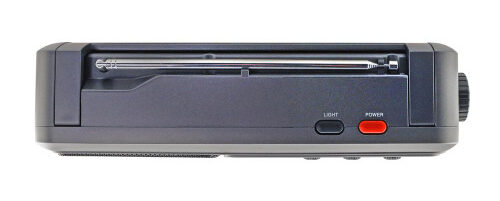 On top of the EP PRO are a red POWER button, a black button for lighting the tuning dial, a flip-up carry handle, and a 36-inch telescoping antenna for FM reception. (Inside the case is a ferrite bar antenna – 12mm x 200mm (7.9″) long with CCrane’s Twin Coil Ferrite® technology.)
On top of the EP PRO are a red POWER button, a black button for lighting the tuning dial, a flip-up carry handle, and a 36-inch telescoping antenna for FM reception. (Inside the case is a ferrite bar antenna – 12mm x 200mm (7.9″) long with CCrane’s Twin Coil Ferrite® technology.)
On the right side of the case at top is the tuning knob, below that a knob for fine-tuning the internal antenna for AM reception, and at the bottom a knob for volume. On the left side of the case, you’ll find a 1/8” stereo headphone jack, a line-in jack, and a socket for plugging in an external 6-volt AC adaptor which is provided with the EP PRO.
On the back of the radio is a hatch for installing four D-cell batteries (CCrane says it will run for about 175 hours at moderate volume with the dial light off), external antenna connections: spring loaded for AM and “F” connector for FM, a switch for selecting internal or external AM antenna, and the switch for selecting 9 or 10 kHz tuning steps.
That’s it. The EP PRO is almost Zen-like in its simplicity. There are no seek buttons, no automatic storage functions, no memories, no key pad. And there is a darn good reason for that. It turns out that the immediate predecessor of the EP PRO, the CCrane EP, was created by Bob Crane because his mother wanted a very simple radio that was easy to operate. The CCrane EP, a true needle and dial analog radio, was the result.
Bob believed that, besides his mother, there was a market for such a radio, and there was. Unfortunately, after a time, the analog chips necessary to build the CCrane EP became unavailable. As a result, the radio was redesigned internally using modern digital chips (essentially the same as those in CCrane’s model 2E and 3 radios) while keeping it simple and easy to operate. So inside what looks like an old-fashioned analog radio beats the heart of a high-performance digital radio that combines the high sensitivity needed to hear distant stations with excellent selectivity to block signals from the side.
In my view, the EP PRO is great fun to operate. In the predawn hours on a weekend morning with the rain falling softly outside, I started tuning slowly across the AM dial with the EP PRO in my lap. Near the bottom end, a couple of sports mavens were chatting about a pitcher who had a couple of rough two initial outings and then had “settled in.”
A bit further up the dial Dionne Warwick was telling me to “walk on by.” Then I ran into a music station competing with a talk show considering “the Bible, angels, and UFOs.”
Up the dial some more, apparently a good deal on a high performance car could be had at a dealership in Connecticut; then an air quality report for New York City, a female voice delivering a long discourse in French and so on up the dial.
I was impressed at the number of stations that the EP PRO was pulling in, and it brought me back to the simple joy of tuning around to see what’s on the air.
Each time a discernible station appeared, the red tuning LED would light up. As needed, I used the antenna tuning knob and the bandwidth selection switch to tweak the signal. The needle and dial tuning gives an approximate indication of where on the band the radio is tuned, so if you want a positive ID, you need to listen for a station ID or some other clue to the station’s location.
At one point I jumped to the FM dial and found I could easily pick up many FM stations even with the whip antenna collapsed. In all, I am of the opinion that both the AM and FM sides of the receiver are pretty “hot,” and at no time did I find myself wishing for an auxiliary antenna for more signal. Further, the sound through headphones or the speaker is very pleasant indeed. In my mind, the relatively unadorned exterior of the EP PRO belies its outstanding performance. To stretch an analogy, it’s a nitro-burning funny car in the body of a Honda Civic, and you don’t have to be a genius to drive it.
If you’re looking for a high-performance radio that is easy to use and sounds good through speaker or headphones, the CCRadio EP PRO delivers the goods. For a content DXer like me, the EP PRO encourages me to tune around and discover the magic of radio all over again.
CCRadio-EP Pro Retailers:
- C.Crane
- Amazon.com (SWLing Post affiliate link)

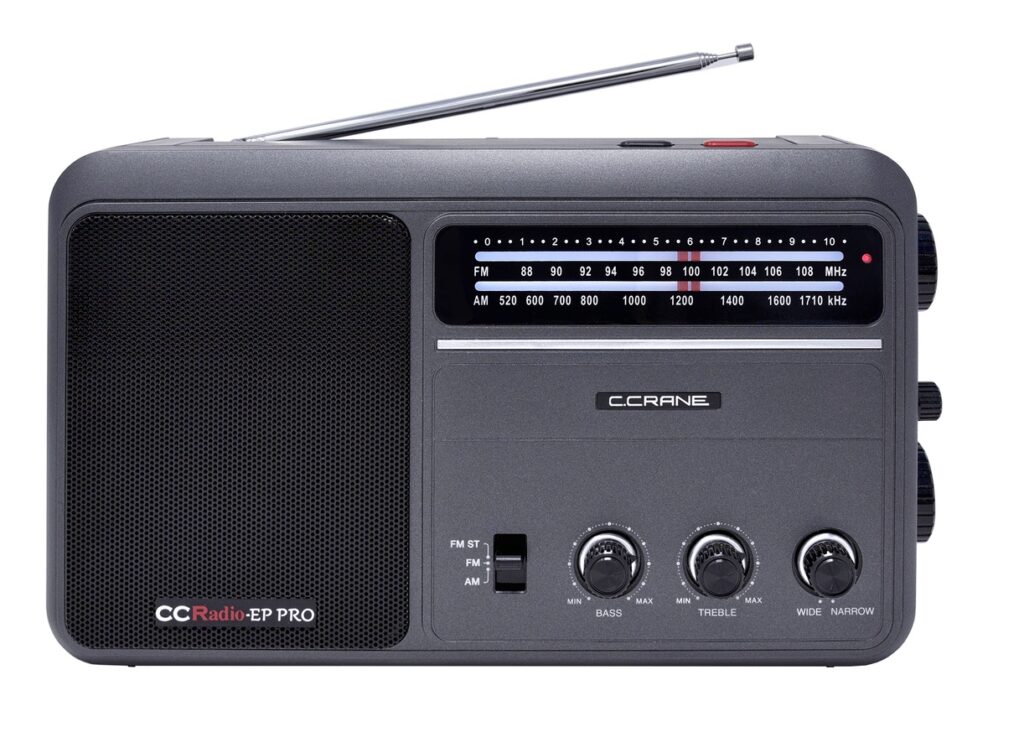
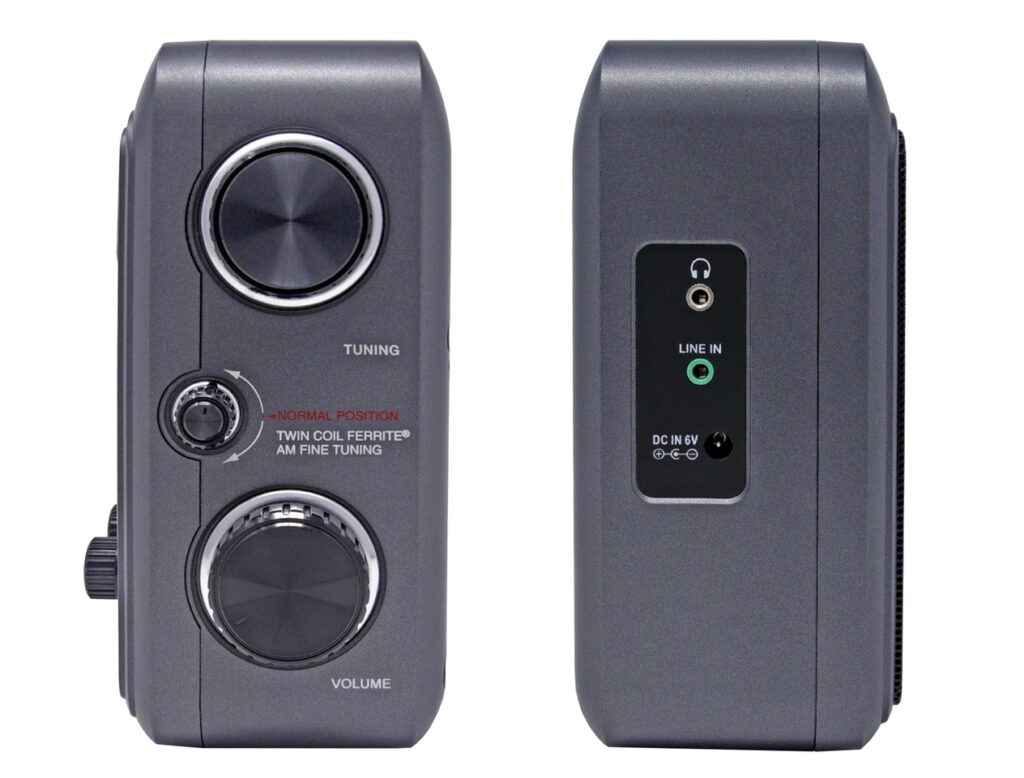
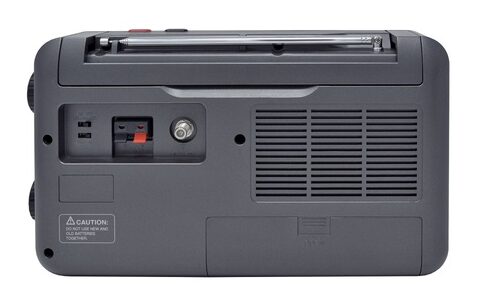
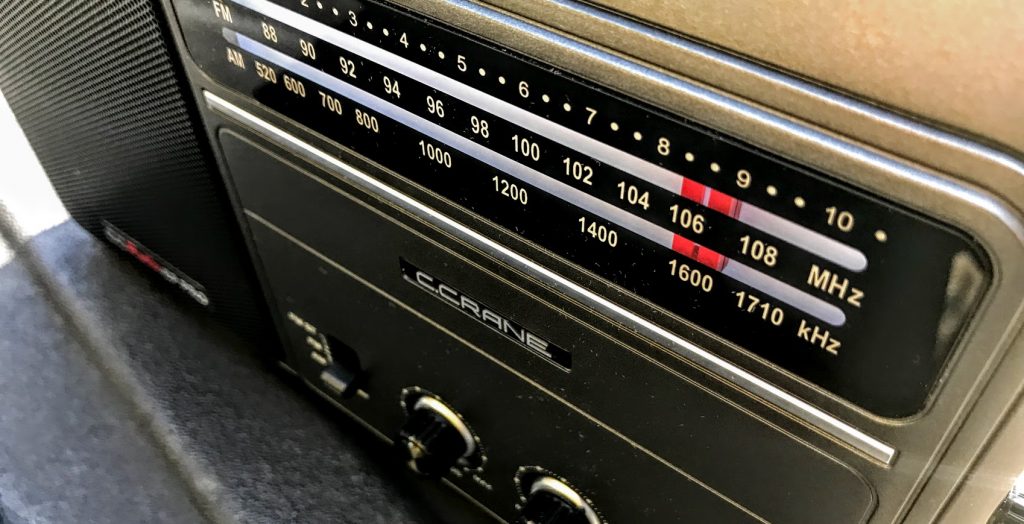
I note from your review that when in the 9kHz-steps AM mode, the highest frequency it receives is 1620kHz. This might be a bit disappointing for anyone planning to use the receiver in Australia, which uses 9kHz AM(MW) steps but does have an extended AM band up to 1701kHz for ‘narrowcasting’ services. Some other countries such as Japan have low-power AM broadcasts on 1629kHz. Maybe the DSP chip designers are unaware of these ‘9kHz AM steps’ countries using frequencies above 1620 ??
You had me at ” predawn hours on a weekend morning with the rain falling softly outside.” Looks like something I’d enjoy playing with. However, my wife recently bought me a Sony ICF-19 AM/FM. REALLY simple radio for just $28. Needle and dial (but digital tuning), this radio is a little too narrow on the AM band (still very sensitive), but some of the smoothest FM sounds I’ve heard. Going on 2 years with those mad D batteries.
Jack K,
You made me smile!
Cheers, Jock
Very concise review & entertaining,Jock.Thank You
Thanks for the kind words, Jack.
Cheers, Jock
I had this radio and unfortunately it drifted. You would lock onto a station, and within about 15 mins it would drift and I’d have to move the dial to lock onto the station again. I would never buy this radio again. Sorry that was my experience!
Hi Jock,
Do you use a turntable with yours? I find it is very sensitive and just barely moving the table at times allows for incredible reception.
Or you could just turn the radio?
Chris,
I did not. I was moving it in my lap. Good idea though.
Cheers, Jock
IMHO, the GE Super Radio I or II is still the BEST AM/FM portable I’ve ever used. I managed to purchase both in pristine, like new condition and will save a lot of money by understanding it will not get perceptibly better.
I agree that the SR-1 and SR-2 are great AM radios.
I have not done it but I have wondered what if one tapped the 455 kHz IF of those GE’s and fed that into the best of today’s software defined receivers to apply sharper filters or digital noise reduction.
I have the previous version of this radio, the EP.
When it was trouble free, it was a notably good performer at night when an AM station 2 miles away and another 4.5 miles away were at low night time power. When these two nearby stations went to 5000 watt day power, images appeared on the original EP radio. If I got in the car during the day and travelled 20 miles from any AM station, the EP radio became a good performer, capable of hearing “in the noise” a 220 mile away 5000 watt AM station on 540 khz. In similar day conditions the EP could pick up WSM AM’s great antenna and 50,000 watt transmitter 190 miles away with “near FM mono” sound quality.
This original EP radio performance is just a bit less than my old Panasonic RF-2200, or the original “analog” Sangean PR-D5, the one with the Max and Min lettering BELOW the volume control. The original EP AM performance is better than the new SiLabs chipped PR-D5 that “runs out of volume” on weak AM signals.
Lately my old EP radio has developed the following fault: when unused for at least an hour and “cold” the radio will turn on and and work normally for a time period of 5 minutes to 15 minutes – then suddenly several AM stations come in at once, and turning the tuning knob has no effect at changing to a single channel – multiple stations are heard at once. Then after a few minutes the sound decreases down to light static. This happens on batteries and AC adapter. Plugging in earphones makes no improvement.
I called C Crane. C. Crane claims
“we have never even had a Service Manual or schematic for the original EP”.
This seems odd – Bob Crane never was shown a pre-production schematic showing the “Twin Coil Ferrite antenna and its unique fine tuning knob?
Based on my radio’s symptoms I was told over the telephone by a C. Crane employee:
“it is probably in the varactor diode tuning section components or the “flakey” potentiometer attached to the main tuning knob”
I was told “If you clean the pot with De-Ox-it that will leave no lube inside the pot for the sliding contact wipers and the pot will wear quickly internally due to lack of lube.”
Internet searches bring up two owner references to “bad tuning pot” on the original EP.
The cold/warm time period conjures up the thought of a bad solder joint or crack in a trace.
If anyone has first hand EP troubleshooting experience, please post.
I know of Electrical Engineer Bruce Carter’s internet page (earmark) on the original EP radio.
Lovely write-up Jock. It’s nice to focus in on a specific feature set and do it right, as it sounds like this radio does.
Do any British (or European) readers know of anything similar for purchase this side of the Atlantic? The inclusion of the 9/10kHz switch implies it is for a global market but I haven’t yet found a British supplier. Maybe CCrane stuff is rebadged for sale in other territories? Failing that, can anyone recommend anything like the above?
Paul,
I do not know of a supplier on your side of the pond; you could reach out to CCrane through this link:
https://ccrane.com/contact-us/
Cheers, Jock
Thanks Jock. Yep, they kindly replied quite quickly to say that Brexit-related issues meant they stopped shipping to the UK and EU, but “we are just about done with the measures and should be back to shipping to the UK and EU in the next month. We do not have an dealer in the UK, so if you need something sooner, then Amazon.com would be the way to go.”
Paul,
I have always found them to be responsive.
Cheers, Jock
Thanks for the review! The one thing I’m disappointed with … only 6 kHz of bandwidth in wide mode? When is somebody going to give us the full 10.2 kHz that is permitted in the US, and that many stations are still broadcasting? And as long as I’m wishing, with the correct NRSC AM deemphasis curve? Seems to me to be an untapped market. An AM radio that sounds as good as it possibly can. What an idea!
DSP chip limitations, I suppose …
I can’t say for sure, because 6khz and 2.5khz seemed like a disappointing number to me too, but maybe that’s khz per side. I remember having the same concern when researching, but by my ears, the numbers on the bandwidth can be disregarded. The wide setting will be too wide if there’s a strong station +/- 10khz on the band and the narrow setting doesn’t sound muffled or underwater so I think both filters are wider than the 9 and the 3.5/2.3 respectively. I’m not entirely convinced the filters on my Tecsun PL880 are remotely as accurate as they claim to be or on portables like it and that’s where I got the idea about 9khz/5/3.5/2.3 and so on.
I have the Tecsun PL330. There is NO WAY that’s 9 khz. I’d be shocked if it was half that.
Are there any radios out there that can take full advantage of what you described? I think I ran into a rental car radio in the mid 1980s that might have closely approximated this. The radio had a wide setting for AM and when selected, the local stations greatly improved in sound quality, rivaling the FM stations on the same radio. Unfortunately, I do not remember the make or model of the car.
Other than genuine professional broadcast monitors and a few esoteric tuners with stratospheric prices, I believe the champ would be the Carver TX-11B, which also ain’t cheap but at least it ain’t thousands of dollars. There are a few AM Stereo stations out there that are feeding their web stream from one, just to show off. (Example: https://i1430.com/ ) The Carver TX-11A has the bandwidth but needs a minor modification to conform to the NRSC deemphasis – it’s a bit too aggressive otherwise.
The Denon TU-680NAB has the deemphasis but is a bit short on the bandwidth (I’d guess about 8 kHz) and has a surprisingly (to me) rolled off bass response. Again, not inexpensive.
In the portable realm, the GE Superradio III (not the I or II) is about as close as you can get. Bandwidth oh yes, deemphasis sort of. (It uses EQ shaping that affects the headphone jack, so you can’t quite dial it in even with the tone controls.) Try and get one of the early GE versions if you’re going that route, since later ones, especially the ones branded RCA instead of GE, have some chronic issues with tuning stability.
Sony made some AM Stereo portables and walkman-type things that have the bandwidth but no deemphasis at all so they’re shrill as heck, and then there’s the officially AMAX-certified SRF-42, which has the deemphasis but only about 7 kHz of bandwidth. Frustrating, ain’t it.
With the FCC-imposed bandwidth limitation of 10.2 kHz, the days of AM matching the fidelity of FM are over, but it still should sound better than it does on most radios. Of course it also depends on the station itself. Many broadcasters, especially the ones that are mostly talk, have limited their transmissions to 5 kHz bandwidth or less because … there are allegedly no wide bandwidth radios. And so the drain keeps being circled …
I don’t doubt that it is good, but is it Panasonic RF-2200 good?
Jake,
I don’t know; I don’t have an RF-2200 for comparison.
Cheers, Jock
Jay Allen says no but good luck buying a 2200.
I have a Panasonic RF-2200 and it’s excellent for AM DX’ing. What it has that the Crane doesn’t is a rotatable AM antenna. These radios are available used on EBay.
Shortwave listening would be pretty difficult on this radio.
Vonu,
True! But Thomas, our maximum leader, describes this site as shortwave listening, then all things radio.
Cheers, Jock
Correct: this radio only covers the AM/Mediumwave and FM bands. It doesn’t include shortwave.
I like almost all of what this radio offers but the one weak spot, IMO, is the speaker. It sounds fine for talk radio but for music it’s not quite ideal. It doesn’t get particularly loud nor does it really offer any kind of dynamic range. I would have liked to see a bit more power and/or a 2-way setup with a tweeter/woofer.
When I want to listen to FM music while working in my garage I will use the 3.5mm headphone out into a steteo bluetooth speaker. That’s really the best way to get enjoyable sound because the internal speaker just isn’t suited for that.
Otherwise, this radio is a gem. It’s somewhat dissapointing the SQ is a bit lacking for music. There are a few FM channels left that still care about what and how they are broadcasting out.
I’ve had this radio for about 7 months. The station I most often listen to, on 790, there’s something internal that is causing a little interference and I don’t know if that’s the case with all of them, I can’t really hear it unless I use the fine tuning though, and it sounds great otherwise, though the tuning light will blink because of it. I wish there was a way to attenuate signals because super strong stations will bleed over and it can be difficult to null them out. Aside from that, this radio is awesome. I listen to it from across the room most of the time plugged into the wall. It’s more than loud enough.
At night, there’s stations on every 10, which makes it fun to just keep it in your lap and dial up and see what you can pick up. It’s easy to keep track of your frequency even in the dark with the light disabled just counting as you go up or down. The radio locks onto the frequency once you’re on it. A lot of cheaper DSP radios really are a pain with tuning, but this one really gives you some margins to operate between and not feel like once you let go of the knob or touch the radio a certain way, that you’ll lose the station. The narrow filter really makes weaker stations cut right in and sound clear and loud but there are a lot of techniques you can use with this radio to clean up the audio before flipping this on and you may find you don’t even need to.
There is a lot of range in just the volume control, just like on a much older tube radio, just keep turning up the volume (just don’t forget you’ve maxed out your volume before you change to a stronger station).
The fine tuning can really peak the signal from there, you can often hear it come up quite a bit. But you can also use this, even at a slight loss of the signal you want, to move a stronger station a little further out of the way if it’s battering you. Then using the bass and treble controls, you can really clean up the sound a lot. Sometimes dialing them both back does the trick, sometimes dialing back the treble and turning up the bass does it. Turning down the treble will really help knock out nearby offending stations. It all depends. What I’m saying is, for a simple radio, there’s a lot to actually fiddle with.
I mostly keep on the AM dial but compared to my other radio I listen to daily, the Tecsun PL880, which does a great job picking up weak FM stations, the CC seems to struggle a little less with the weak ones, but that’s an anecdotal observation. On the PL880, I’ll often just turn on SSB on weak AM stations to try to find bring them out, and you don’t have that option on the EP but 9 times out of 10, the EP ends up doing a better job. Of course it has a bigger antenna and speaker too.
I often looked this radio up for a couple years (online window shopping) before I bought it so by the time I got it, I had high expectations and it’s definitely within those expectations.
Wow, Ted, that’s a lot of good information as well as tips and tricks.
I particularly like:” It’s easy to keep track of your frequency even in the dark with the light disabled just counting as you go up or down.”
Thanks for your comments based on 7 months of usage.
Well done!
Cheers, Jock
Looks like a rebirth of the venerable GE Super Radio. I still have mine ant it works great.
Steve,
On their website, CCrane does say this: “. The portable CCRadio-EP PRO could be considered a super radio . . .”
Congrats on your GE Super Radio.
Cheers, Jock
Yep, the GE Super Radio and I still have mine too.
Thanks, Jock for the excellent review. This sounds like a radio I need to pursue since I’m an avid AM BC band DX’er. The simplicity of design is definitely a plus but is not the only draw; the large speaker and the fact that it’s powered by four hefty D batteries (like my Panasonic RF-2200) which probably’ll last many hours are additional desirable traits. It’s reminiscent of the large rudimentary portable radios produced in the ’60’s and 70’s.
Thanks again Jock for the in-depth review and thanks Thomas for posting.
Mario,
Thanks for the kind words, and you might want to print out a copy of Ted’s comments above.
And, yeah, I plan some early morning AM BC DXing with the EP PRO.
Cheers, Jock
Thanks for the great review; especially in noting such great long distance reception using only the built-in antennas! I want to explore AM DXing. This sounds like a great contender.
Tim,
I think it is a great contender . . . and AM DXing is fun!
Cheers, Jock
The original EP PRO used analog tuning (variable capacitor in the tuning tank circuit). The new EP PRO radios use a DSP (Digital Signal Processing) and will use 10 kHz “steps” tuning on the MW band, 9kHz steps for Europe. That is the reason for the 9/10 switch.
George,
Agreed.
Cheers, Jock
Nice review, Jock!
I have one of the original design EPs, and it is indeed a joy to use such a “simple” radio. And, call me old fashioned if you will, but I like using “D” sized batteries – they are reliable, long-lasting, and really, really long -lasting!
Cheers!!
Robert,
Fine business on your original EP, and the EP PRO is also a joy to use.
I agree on the D cells . . . they just keep on truckin’.
Thanks for the kind words.
Cheers, Jock